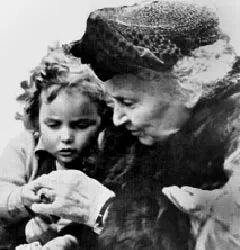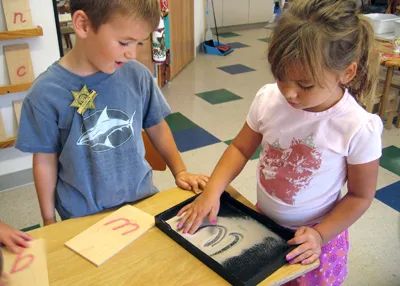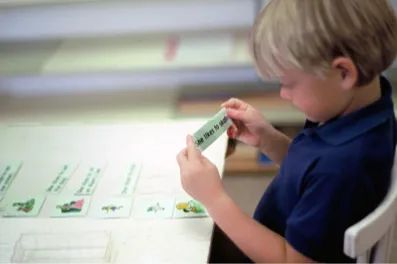Man’s True Nature Lies Hidden within Himself
The true nature of children has been concealed. The dominant vision of the child in today’s world can be compared to that of the solar system in the 1600s ; both are points of view that lack a part of the facts which gives rise to an astonishing discovery. In Galileo’s time the discovery was that the earth travels in an elliptical orbit around the sun in the center. In Maria Montessori’s time the discovery was that of the true nature of the child, and with him, the nature of mankind. This new found nature has since then kept appearing over and over again in Montessori schools all over the world. It is a nature far beyond what adults usually think.

Maria Montessori said, “The goodness of a child was measured by his adaptation to the conditions of adult life and vice versa. Because of this erroneous opinion the natural traits of children lay hidden. Adults no longer recognized what was good for, and in, the child as nature intended it to be.”
Two Streams of Energy
Dr. Montessori states that in the growing child there are two streams of energy whose balanced interplay is of the utmost importance: psychic and physical. Mind and body should never be thought of as separate. If during the child’s development these two were separated from each other, we should expect to find deviations from the normal. And this is exactly what we find.

In reality these two streams of energy are separated when the child has the will to act but his movements are restrained, when the will of the adult is substituted for that of the child or when he simply does not find in his environment the materials he needs to bring together these two factors. If any of the latter happen often enough Montessori observed that a deviation will be formed in the child’s behavior. These deviations are what we often think of as characteristics of the child.
Nature is the wisest of all mothers; she knows the child has to undertake a tremendous amount of work in order to perfect the abilities internally engraved in the human blueprint. In response to this necessity, she grants him enormous amounts of energy which is meant to be used in work. This work of the child is the creation of the individual.
Excess Energy
The child is constantly looking to use such energy, but when the adults stand in the way saying “don’t touch!” or “stay still!” they are forcing him to go against the commands of nature and thus, causing a deviation in the child. Since he was unable to work in his intended activity, and what is worse was forced to stay still, the child now possesses an excess of energy. Anyone who has seen an electrical storm may understand that such excess is not a good thing, for energy is meant to be in balance. We may ask, if the adult is actually responsible for keeping the child from work, is it really fair that he blames the child for his energy excess?
The deviations of a physical type are easy to recognize because we have in our minds a role model for what is considered normal. We expect five fingers on each hand, one head, one nose, two eyes, one mouth, etc. If we see something that doesn’t fit into that model then we know there’s a deviation. However, in what Montessori called the psychical field the deviations are not so easy to recognize because we don’t have in our minds a clear pattern of what is normal.

Before talking about normality I would like to explain the different types of deviations that Dr. Montessori found in children. These we can divide into two groups, taking as a base the definitions used by today’s child psychologists. The first one contains all the traits regarded as abnormal, such as lying, disorderly and destructive movements, continued disobedience, timidity, gluttony, and irrational fears, among others. In the second group are the deviations which are usually thought to be normal traits of childhood, such as possessiveness, extreme attachment to a person, the excessive development of make-believe (like imaginary friends), the constant asking of questions without waiting for an answer, and finally a deviation regarded by psychologists as one of the very basic traits of childhood, the instability of attention.
A New Mentality
Over 100 years ago, all of these were the characteristics that adults accepted about childhood before Maria Montessori discovered a whole new world hidden in the soul of a child. It may be said that it happened by chance. One day she saw a little girl in her class working with the cylinder block, completely focused, entirely oblivious of her surroundings. Dr. Montessori tried to distract the child by moving her, but the child just calmly readjusted to the new position, took the material again and kept on working. In another attempt to distract, Dr. Montessori had the other children sing and march around the child. Despite Dr. Montessori’s efforts the child kept on working, repeating the exercise more than 40 times with the calm of one who is inspired. Once the child decided she was finished she looked around and smiled like waking up from a refreshing nap.
In addition, similar moments began to appear in the other children. Through their self-chosen work, they gradually transformed themselves into children who loved order and silence, refused punishment and rewards, were completely self-disciplined, able to attain amazing concentration over long periods of time and were constantly looking to perfect themselves. These children actually preferred work over play, refused candies, were attracted to reality instead of fantasy, were polite, independent, willingly obedient and showed a great deal of self-dignity. But above all, those children were genuinely happy. All these were the characteristics that Montessori found to be the true normal traits of childhood.

This is how it was discovered that as soon as children find something that interests them, they lose their instability and naturally begin to concentrate. She wasn’t looking to find the characteristics of a normal child. She wasn’t expecting them, not even thinking about them. It was a genuine and unforeseen revelation that she discovered. Race, color, climate, religion, and civilization-- all this made no difference. No matter where in the world Montessori traveled, as soon as a deviation in the classroom was removed by providing meaningful activities in the environment, the same traits began to appear in the children.
Redefining Childhood Traits
There are many types of psychical deviations found in children. However we no longer recognize them as childhood traits, but rather as symptoms of psychical illness. The good news is that for all those illnesses there is one simple cure–normalization through work – and through this “cure” those children who were once regarded as naughty can discover their own inner potential and be transformed into a wonderful manifestation of mankind’s true nature. It was also discovered that normalization through work was a cure not only for psychical disorders but this process could actually improve the physical health of the children. In some parts of the world, Montessori schools are actually referred to by pediatricians as “Casa della Salute,” or “Health Homes.”

After this amazing discovery Montessori categorically asserted that through the renewal of education, it would be possible to produce a better type of man endowed with superior characteristics, and that the opportunity to change the world lies within the child. This is why she was nominated for the Nobel Peace Prize three years in succession- in 1949, 1950, and 1951.
This normalization keeps being rediscovered all over the world each time a new child finds his true nature. Montessori described it in these words: “What is to be particularly noted in these child conversions is a psychic cure, a return to what is normal. Actually the normal child is one who is precociously intelligent, who has learned to overcome himself and to live in peace, and who refers a disciplined task to futile idleness. When we see a child in this light, we would more properly call his “conversion” a “normalization.” Man’s true nature lies hidden within himself. And this nature, which was given him at conception, must be recognized and allowed to grow.”




















